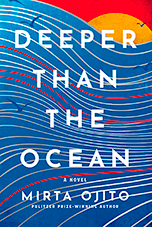About My First Novel

Dear Reader, Deeper than the Ocean is the book I owed my mother. In many ways, this is her novel, as it is fused with the stories that she regaled me with up until the day she died ...
That day I went to see her to take her grocery shopping as I did every week. When we came back, we had a lunch she assembled from delicious leftovers and then we sat and talked. As always, more so as she aged, her stories meandered to her mother, Catalina Quintana, who died too young; and to her childhood in a remote corner of Cuba living in a dirt-floor house with four younger siblings and a stern, illiterate father.
My mother was a natural storyteller, and, recognizing this, I had been taking notes of our talks. That Sunday, our last together, I pulled out my phone and began recording her. I don’t think she noticed. Or, if she did, it didn’t stop her from unspooling her tale.
At the time I was deep into the writing of a novel about the 1919 shipwreck of the Valbanera, a ship full of Spanish immigrants that left the Canary Islands on its way to the Americas. Half-way through the voyage, after stops in Puerto Rico and Cuba, the ship succumbed to the winds of a killer hurricane and sank deep into the muddy sands off the coast of Key West. Though the ship was found a few days later, the bodies of 488 people were never found, forever lost to their loved ones, but not to history.
And yet, I had never heard about it until 2006, when walking on the streets of Key West I happened to notice a coffee table book for sale on a table outside a gift shop. The title of the book immediately grabbed me, as it was in Spanish, "El misterio del Valbanera". I bought it for $10 and began reading it soon after I reached the hotel. How did I not know about this sad story of immigrants losing their lives to the sea?
I remember looking out my window to the sea and thinking of all the souls lost in the treacherous ninety miles of water that both separate and unite Key West and Cuba. As a reporter, I’ve covered countless of similar stories: immigrants losing their lives to the sea in pursuit of a dream, the same dream of a better life that fueled my own leaving Cuba at sixteen, also in a boat, though a much smaller one than the Valbanera.

Image: Courtesy of Fernando García Echegoyen
Years went by, but the story of the doomed ship stayed with me until one day, seemingly out of nowhere, the tale of a family from the Canary Islands began to take shape in my mind as easily as if I had always known them. From the beginning, the main character took on my grandmother’s name, Catalina. And, before I knew it, my mother’s stories found their way to my pages. The more I wrote, the more the story became about my mother, though that had never been my original intention.
Some early readers have asked me how much of this book is true and how much it’s a product of my imagination. That’s an almost impossible equation to calculate. It’s as difficult as trying to answer the question of where ideas come from, but I’m certain that this novel was my mother’s last gift.

Once Upon a Picture
I found these pictures in the book that inspired my novel, "El misterio del Valbanera" (The Mystery of the Valbanera) by Fernando García Echegoyen. The pictures helped me set the mood and describe scenes that greatly enriched my work. Yes, I could have imagined this ship, those rooms, those faces, but it is far better to remember and honor them as they were -real men and women who lost their lives in an unimaginable tragedy.
Images: Courtesy of Fernando García Echegoyen
Tap on the image to see its description
There are very few pictures of my mother's adolescence and youth and none of her childhood. In fact, these are all the pictures I have of my mother before she married my father in 1962.
I treasure them, not only because they reveal a young woman I never knew but also because as I worked in my book they inspired the characters I created. Catalina, Carmen, Ana, and Lila are all here; they are the women in these pictures. My grandmother, who died when my mother was just sixteen, was named Catalina Quintana, just like the character. I'd like to think I got to know her through the pages of this book.
Tap on the image to see its description
Related Videos
About Mirta Ojito

Mirta Ojito is a journalist, professor and author of two previous non-fiction books. She is the recipient of an Emmy for the documentary Harvest of Misery as well as a shared Pulitzer for national reporting in 2001, for a series of New York Times articles on race. A refugee from Cuba, her work often explores the complexities of identity, belonging, and the quiet power of resilience. She lives in Coral Gables, Florida, where she is endlessly inspired—and occasionally outnumbered—by her three grown sons and too many plants. Deeper than the Ocean is her first novel.
Her work has appeared in several anthologies, including Written into History: Pulitzer Prize Reporting of the Twentieth Century from The New York Times, edited by Anthony Lewis. Ojito has taught journalism at New York University, Columbia University, and the University of Miami. She is currently a senior director for News Standards at NBCUniversal.












